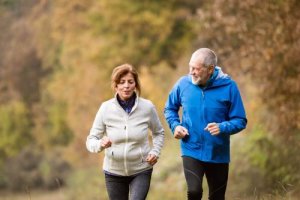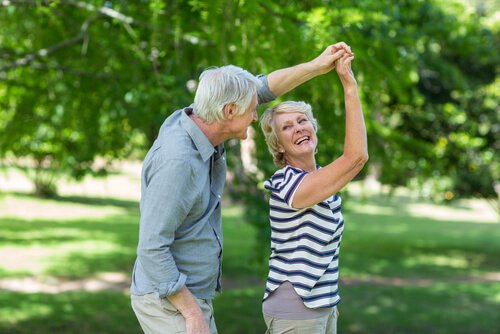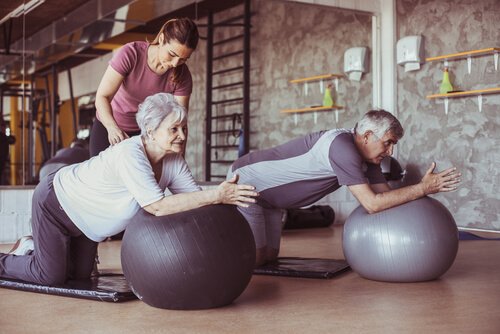4 Benefits of Physical Activity for the Elderly

It’s important for us to stay fit and healthy, taking into account that all of us are continually getting older. Because of this, in this article, we’re going to tell you all about the benefits of physical activity for the elderly.
We’ll be talking about exercise that’s very easy to carry out, and doesn’t need to be intense. It doesn’t need to be any particular activity either.
Something that is clear is that, as we age, our cardiovascular and respiratory systems get weaker. In addition to that, there is a deterioration in the musculoskeletal and nervous systems. Carrying out regular physical activity, even in old age, is essential in order to delay the physiological aging process.
Health experts recommend regular exercise for the elderly, as it offers innumerable benefits, and helps to make our lives useful for longer. According to the National Institute for Ageing, exercise is good for people of any age and can alleviate the symptoms of many chronic diseases. Contrary to popular belief, weakness in our bodies and lack of balance are more linked to inactivity than to age.
4 benefits of physical activity for the elderly
The benefits of physical activity for the elderly are many. For that reason, we’re going to be highlighting the 4 most important ones for you today.

1. It strengthens the heart
When older people carry out physical activity, their muscles need more oxygen to function. To meet this need, the heart has to perform work that is much more demanding. The channels the blood travels through are no longer as free nor as functional as they used to be. This is because there is no longer as much strength to pump oxygen around the body.
So, when adults carry out physical activity, it helps them to consolidate and maintain the heart’s ability to relax. In addition to that, it reduces the risk of hypertension and cardiovascular diseases, as well as reducing difficulty in breathing.
Besides that, cardiovascular exercise for the elderly cleanses the respiratory tract and helps fight common diseases, such as a simple cold or flu.
2. It decreases body fat levels
Aging is accompanied by a gradual decrease in muscle mass, better known as sarcopenia. Physical activity is an excellent way of slowing down sarcopenia and improving muscle tone.
A high percentage of body fat is linked to a wide variety of diseases, including cardiovascular diseases and diabetes. Regular exercise burns body fat, increases muscle mass, and accelerates metabolism, which is great for older people (and for the not so old too).
“It doesn’t matter how slowly you go, as long as you do not stop”
-Confucius
3. It reduces the risk of developing diseases
Physical activity reduces the risk of developing serious diseases. In addition to that, it can even minimize the negative impact of some symptoms when certain conditions have already developed.
By means of an example, we can look at dementia and Parkinson’s disease. Regular exercise by people who suffer from these conditions can help maintain balance and coordination, in addition to increasing functional independence. And finally, just the fact that they are taking part in physical activity is an important source of well-being for them.

4. Physical activity for the elderly improves mental health
Among all the benefits of physical activity in the elderly, an improvement in mental health is one that particularly stands out. Keep in mind that exercise is a natural mood enhancer. This is because the body releases endorphins that make those who practice it feel good.
Because of this, exercise is recommended for older people who are struggling with the psychological effects of aging, as it can be the key to give them momentum and energy.
As you can imagine, physical activity not only brings physical benefits for the elderly, but it also improves emotional well-being, self-esteem, and quality of life. In addition to that, sport creates social bonds and decreases the risk of depression.
What type of physical activity for the elderly is best?
Now that we have discussed the benefits of physical activity in the elderly, it’s an ideal moment to have a brief look at some of the exercises they can carry out.
1. Aerobic and resistance exercises
Doctors recommend that the elderly perform 30 minutes of cardiorespiratory endurance exercise each day, in order to raise the heart rate and speed up breathing. Walking, riding a bike, or swimming are all good examples of low-impact aerobics.
2. Strength training
Strength training develops the muscles through repetitive movements. Older people can carry out strength training with weights, resistance bands or machines. They can adapt the weight to their physical condition and capacity.
3. Stretching exercises
Stretching is perhaps the best way to end a workout. These exercises stimulate muscle relaxation after a period of physical activity. They enable the body to recover after exercise and prepare the body for future activity.
If these stretching exercises are carried out correctly, then they will improve and maintain flexibility, thus avoiding injuries and reducing muscle pain and stiffness in the elderly.

In short, regular physical activity helps to reduce the effects of aging on the muscles and cardiorespiratory function, thereby improving quality of life. It increases our chances of being able to continue enjoying a good quality of life and the health that comes with it.
Finally, we must remember that it is much better if this exercise is carried out in a controlled way, under supervision. We should avoid overexerting ourselves, which could actually produce the opposite effect that we are trying to achieve.
It’s important for us to stay fit and healthy, taking into account that all of us are continually getting older. Because of this, in this article, we’re going to tell you all about the benefits of physical activity for the elderly.
We’ll be talking about exercise that’s very easy to carry out, and doesn’t need to be intense. It doesn’t need to be any particular activity either.
Something that is clear is that, as we age, our cardiovascular and respiratory systems get weaker. In addition to that, there is a deterioration in the musculoskeletal and nervous systems. Carrying out regular physical activity, even in old age, is essential in order to delay the physiological aging process.
Health experts recommend regular exercise for the elderly, as it offers innumerable benefits, and helps to make our lives useful for longer. According to the National Institute for Ageing, exercise is good for people of any age and can alleviate the symptoms of many chronic diseases. Contrary to popular belief, weakness in our bodies and lack of balance are more linked to inactivity than to age.
4 benefits of physical activity for the elderly
The benefits of physical activity for the elderly are many. For that reason, we’re going to be highlighting the 4 most important ones for you today.

1. It strengthens the heart
When older people carry out physical activity, their muscles need more oxygen to function. To meet this need, the heart has to perform work that is much more demanding. The channels the blood travels through are no longer as free nor as functional as they used to be. This is because there is no longer as much strength to pump oxygen around the body.
So, when adults carry out physical activity, it helps them to consolidate and maintain the heart’s ability to relax. In addition to that, it reduces the risk of hypertension and cardiovascular diseases, as well as reducing difficulty in breathing.
Besides that, cardiovascular exercise for the elderly cleanses the respiratory tract and helps fight common diseases, such as a simple cold or flu.
2. It decreases body fat levels
Aging is accompanied by a gradual decrease in muscle mass, better known as sarcopenia. Physical activity is an excellent way of slowing down sarcopenia and improving muscle tone.
A high percentage of body fat is linked to a wide variety of diseases, including cardiovascular diseases and diabetes. Regular exercise burns body fat, increases muscle mass, and accelerates metabolism, which is great for older people (and for the not so old too).
“It doesn’t matter how slowly you go, as long as you do not stop”
-Confucius
3. It reduces the risk of developing diseases
Physical activity reduces the risk of developing serious diseases. In addition to that, it can even minimize the negative impact of some symptoms when certain conditions have already developed.
By means of an example, we can look at dementia and Parkinson’s disease. Regular exercise by people who suffer from these conditions can help maintain balance and coordination, in addition to increasing functional independence. And finally, just the fact that they are taking part in physical activity is an important source of well-being for them.

4. Physical activity for the elderly improves mental health
Among all the benefits of physical activity in the elderly, an improvement in mental health is one that particularly stands out. Keep in mind that exercise is a natural mood enhancer. This is because the body releases endorphins that make those who practice it feel good.
Because of this, exercise is recommended for older people who are struggling with the psychological effects of aging, as it can be the key to give them momentum and energy.
As you can imagine, physical activity not only brings physical benefits for the elderly, but it also improves emotional well-being, self-esteem, and quality of life. In addition to that, sport creates social bonds and decreases the risk of depression.
What type of physical activity for the elderly is best?
Now that we have discussed the benefits of physical activity in the elderly, it’s an ideal moment to have a brief look at some of the exercises they can carry out.
1. Aerobic and resistance exercises
Doctors recommend that the elderly perform 30 minutes of cardiorespiratory endurance exercise each day, in order to raise the heart rate and speed up breathing. Walking, riding a bike, or swimming are all good examples of low-impact aerobics.
2. Strength training
Strength training develops the muscles through repetitive movements. Older people can carry out strength training with weights, resistance bands or machines. They can adapt the weight to their physical condition and capacity.
3. Stretching exercises
Stretching is perhaps the best way to end a workout. These exercises stimulate muscle relaxation after a period of physical activity. They enable the body to recover after exercise and prepare the body for future activity.
If these stretching exercises are carried out correctly, then they will improve and maintain flexibility, thus avoiding injuries and reducing muscle pain and stiffness in the elderly.

In short, regular physical activity helps to reduce the effects of aging on the muscles and cardiorespiratory function, thereby improving quality of life. It increases our chances of being able to continue enjoying a good quality of life and the health that comes with it.
Finally, we must remember that it is much better if this exercise is carried out in a controlled way, under supervision. We should avoid overexerting ourselves, which could actually produce the opposite effect that we are trying to achieve.
This text is provided for informational purposes only and does not replace consultation with a professional. If in doubt, consult your specialist.







